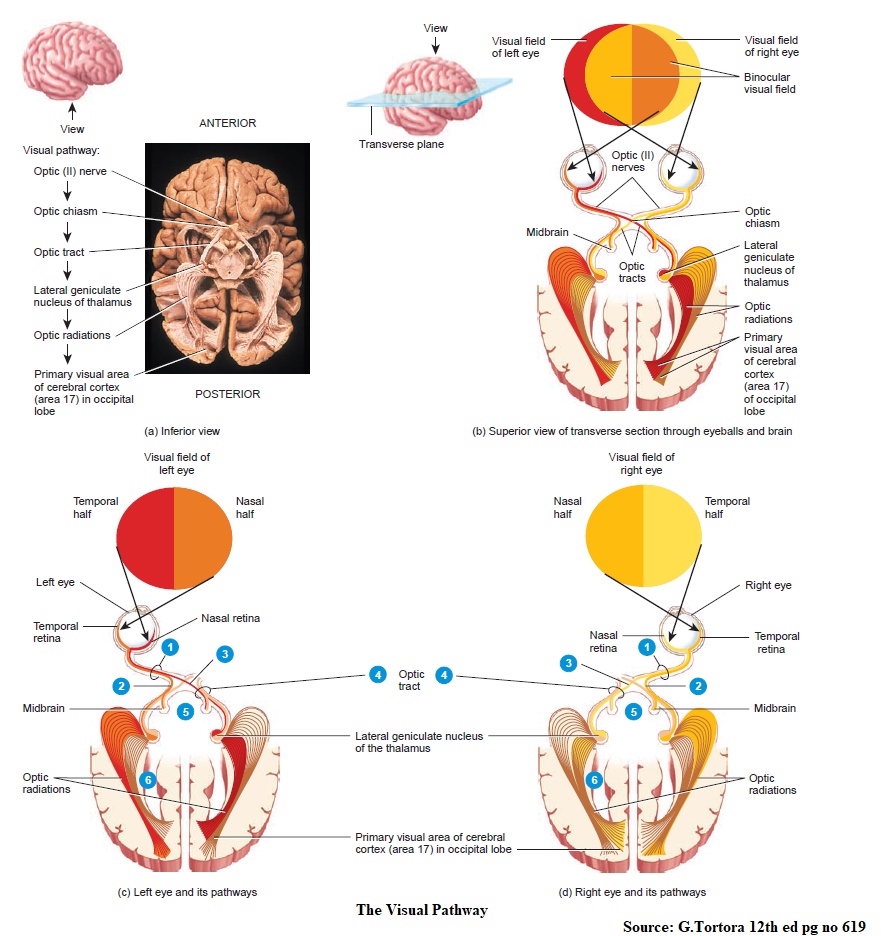Physiology of Vision, Visual Pathways and MCQs for NEET, GPAT, NIPER JEE
Physiology of Vision
Rods and cones are named differently according to the appearance of outer segment. the outer segment of rods have rod-shaped and those of cones have cylindrical or cone-shaped. Transduction of light energy into receptor potential (conversion of light energy into electrical signals) occurs in the outer segment of rods and cones. The photo-pigments are the integral proteins in the plasma membrane of outer segments. The inner segment contains Golgi complex, mitochondria etc. The one end of photo-receptors is an expanded bulb-like synaptic terminal. these terminals are filled with synaptic vesicles.
The first step in transduction is absorption of light by the photo-pigments. the rods have one type of photo-receptor known as rhodopsin; while the cones have 3 photo-pigments, one for each type of cone. All photo-pigments which are associated with vision have 2 parts- a glycoprotein known as opsin and the derivative of vitamin A called retinal. Retinal is light absorbing part of all visual photopigments.
The photopigments reacts to light in following steps-
- In darkness, the retinal has bent shape and is known as cis retinal which fits into the opsin part of photopigment. When the cis-retinal absorbs a photon, it changes its shape and becomes trans retinal. This cis to trans conversion is known as isomerization. During this step, several chemical changes takes place which leads to the production of receptor potential.
- After a min, the trans retinal completely separates from the opsin part of photopigments. this step is known as bleaching of photopigment.
- The trans retinal is converted back to cis retinal by an enzyme called retinal isomerase.
- The cis retinal then again binds back with the opsin part, hence reforming a photopigment. This step is known as regeneration of photopigment.
As studied earlier, the chemical changes that takes place during the isomerization leads to the production of receptor potential. In darkness, the Na ions flow into the photoreceptors outer segment through a ligand. this ligand is known as cGMP( cyclic guanosine monophosphate). The inflow of Na ions is known as dark current.
Visual Pathways
The visual pathways include two events-
- processing of visual data in the retina:-Once the receptor potential arises in the outer segment, it spreads to the inner segments and then to the synaptic terminals. At the synaptic terminals, the rods and cones releases neurotransmitter. The signals then reaches to the bipolar cells, and to the horizontal cells and amacrine cells. The amacrine cells then transmit information to the ganglia cells. once ganglia cells gets the information it depolarises and produces nerve impulses.
- brain pathways:- The nerve impulses produced are then carried ahead. The axons of optic nerve passes through optic chiasm, a crossing point for optic nerve. after passing through the optic chiasm, the axons are now in optic tract where they enter brain and the lateral nucleus of the thalamus. Here the axons form the optic radiations. these radiations projects into the visual areas of occipital lobe of cerebral cortex and the visual perceptions begin.
Multiple choice questions(MCQs)
1. Which organ facilitates the physiology of vision?
A. eye B. ear
C. nose D. tongue
2. What does transduction of light energy mean?
A. conversion of light energy to mechanical energy
B. conversion of light energy to chemical energy
C. conversion of light energy to electrical energy
D. both B and c
3. The inner segment of photoreceptors contains?
A. mitochondria B. golgi complex
C. cell nucleus D. all of the above
4. Match the following-
a)synaptic terminals 1. Passes signals to Horizontal cells
b) bipolar cells 2. Passes signals to Amacrine cells
c)horizontal cells 3. Passes signals to Ganglia cells
d)amacrine cells 4. Passes signals to Bipolar cells
5. The retinal part of photopigment is a derivative of?
A. vitamin A B. vitamin B12
C. vitamin c D. vitamin k
6. In which step the chemical changes takes place?
A. isomerization b. bleaching
C. regeneration D. none of the above
7. Which of the following statement is NOT true?
A. axons of optic nerve first crosses optic chiasm
B. inflow of Na ions is known as light current
C. cGMP releases glutamate
D. during regeneration, cis retinal fits back into opsin part
8. What is the full form of cGMP?
A. cyclic guanosine mono-potassium B. cyclic guanosine monophosphate
C. cyclic guanosine mini-phosphate D. central guanosine monophosphate
9. which of the following are involved in brain pathway?
A. horizontal cells B. amacrine cells
C. ganglia cells D. none of the above
10. Where do the optic radiations form?
A. optic chiasm B. ganglia cells
C. optic tract D. bipolar cells
ANSWERS:-
1. eye
2. conversion of light energy into electrical energy
3. all of the above
4. a) – 4 b) – 1 c) – 3 d) – 2
5. vitamin A
6. isomerization
7. inflow of Na ions is known as light current
8. cyclic monophosphate
9. none of the above
10. optic tract
Participate in Online FREE GPAT TEST: CLICK HERE
Participate in Online FREE Pharmacist TEST: CLICK HERE
Participate in Online FREE Drug Inspector TEST: CLICK HERE
REFERENCE:-Gerard J. Tortora -Principles of anatomy and physiology; edition twelfth ; page no.-: 615-619.
